Sunday, July 31, 2005
National Geographic The best photo collections
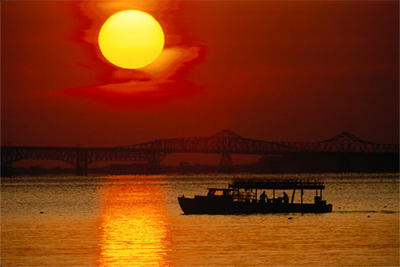
Where: Bay Ridge, Maryland
When: 1992
Photographer: Robert W. Madden
With the Chesapeake Bay Bridge in the background fishers set crab lines in North America's largest estuary. Overharvesting and environmental damage have led to a decrease in adult crab populations in the bay.
(Photograph shot on assignment for, but not published in, "Chesapeake Bay: Hanging in the Balance," June 1993, National Geographic magazine)
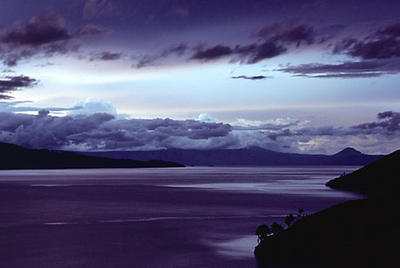
Where: Sumatra island, Indonesia
When: 1980
Photographer: David Alan Harvey
About 74,000 years ago, a volcano erupted and collapsed in on itself on Sumatra. The resulting crater later filled with water and became known as Lake Toba (pictured).
(Photograph shot on assignment for, but not published in, "A Sumatran Journey," March 1981, National Geographic magazine)

Where: Ghazni, Afghanistan
When: 1946
Photographer: Maynard Owen Williams
"Oxen and donkeys tread the bygone glories at Ghazni, seat of conquerors. To Ghazni, Afghanistan's great empire builder Mahmud carried back the plunder of India almost ten centuries ago. Ghazni's splendor died in 1152 when the Indian prince Ala-ud-Din gave it fire and sword. In 1839 the British stormed Ghazni and blew in this gate."
—From "Back to Afghanistan," October 1946, National Geographic magazine
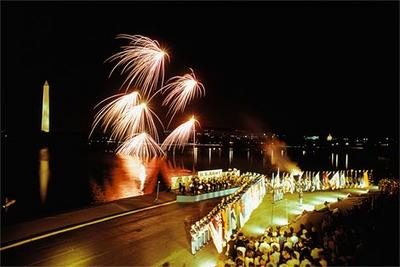
Where: Washington, D.C.
When: Date Unknown
Photographer: Terry Eiler
Fireworks explode and are reflected in water by the Washington Monument. The first public Fourth of July party at the White House occurred in 1801.
(Photograph shot on assignment for, but not published in, the National Geographic book The Revolutionary War: America's Fight For Freedom, 1967)
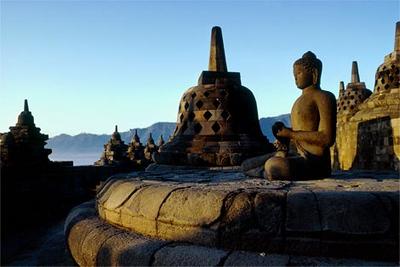
Where: Near Majalang, Java, Indonesia
When: 1982
Photographer: Dean Conger
Home to hundreds of Buddha statues, the 1,200-year-old Borobudur temple is the world's largest Buddhist monument.
(Text adapted from and photograph shot on assignment for, but not published in, "Indonesia Rescues Ancient Borobudur," January 1983, National Geographic magazine)

Where: In the Crab Nebula
When: Date Unknown
Photographer: Palomar Observatory
"At the [Crab Nebula's] core lies a pulsar, a type of neutron star, discovered by radio astronomers in 1968. Only 12 miles [19 kilometers] across, it spins 30 times a second, spewing out high-energy particles. As particles flow out, they lose energy and emit radiation in longer wavelengths. Highlighted in false color, an optical image shows intermediate-energy particles from the pulsar (blue) along with material ejected into space by the supernova explosion itself (green and red)."
—From "Super X-ray Vision," December 2002, National Geographic magazine

Where: India
When: 2004
Photographer: William Albert Allard
"[Film star] Amitabh and a tattered Shah Rukh frame former Miss World Aishwarya Rai. Such posters lure India's star-obsessed populace into the movies' fantasy realm, where true love and justice always prevail."
—From "Welcome to Bollywood," February 2005, National Geographic magazine

Where: Loango National Park, Gabon, Africa
When: 2003
Photograper: Michael Nichols
"Within a modest radius of ten miles (16.09 kilometers), photographer Michael Nichols found a dramatic sampling of creatures that pass through the Loango area. Canoeing on the Echira River, he surprised an elephant swimming in the murky waters."
—From "Gabon's Loango National Park," August 2004, National Geographic magazine

Where: Katmai National Park and Preserve, Alaska
When: 1969
Photographer: Winfield Parks
"A 1912 eruption [from Mount Martin at Katmai National Park and Preserve] spewed ash as far as Washington state, shredded clothes on lines a hundred miles (160 kilometers) away, but, amazingly killed no one. From a new vent, Novarupta, incandescent pumice flowed down the valley in a glowing avalanche. Woodland pickets, killed by hot mudflows, spike the pale plain."
—From the National Geographic book Alaska, 1969
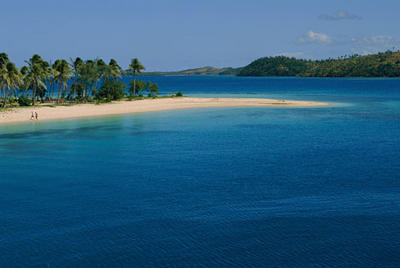
Where: Near Turtle Island, Fiji
When: 1993
Photogrtapher: James L. Stanfield
"Fiji is a nation of islands. Many of them are low coral or limestone hideaways of palm trees, trade winds, and white sand."
(Text from and photograph shot on assignment for, but not published in, "The Two Worlds of Fiji," October 1995, National Geographic magazine)
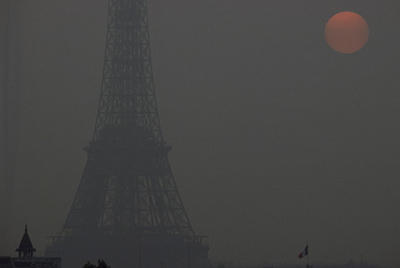
Where: Eiffel Tower, Paris, France
When: 1988
Photographer: James L. Stanfield
"'The legacy of the [French Revolution] is still very much alive,' said Jean-Noël Jeanneney, energetic director of the bustling Bicentennial Mission, headquartered near the Eiffel Tower. 'A nation is rich in its memory. And the roots of 20th-century France are in its founding myth. I'd like all the youth of this nation to know its story—so full of passion and surprise.'"
(Text from and photograph shot on assignment for, but not published in, "The Great Revolution," July, 1989 National Geographic magazine)
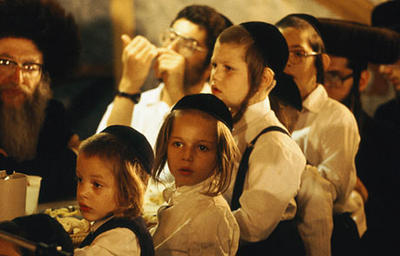
Where: Jerusalem, Israel
When: 1984
Photographer: James L. Stanfield
"With an average birthrate of six children per family, the ultra-Orthodox population in Jerusalem is surging. [In 1996] roughly 30 percent of the city's 420,000 Jews [were] ultra-Orthodox, as [were] 50 percent of the schoolchildren [such as the Ultra-Orthodox men and boys at this Hasidic temple].
"If trends continue, the ultra-Orthodox population will increase by 70 percent here by the year 2010 and will exert significant influence on the city's destiny."
(Text from "The Three Faces of Jerusalem," April 1996, National Geographic magazine)

Where: Tasmania, Australia
When: 1996
Photographer: Sam Abell
Despite the calm waters in front of this boat shed, the island of Tasmania is known for treacherous seas. Since the wreck of the Sydney Cove in 1797 there have been around a thousand ships lost in the area.
(Photograph shot on assignment for, but not published in, the National Geographic book Australia: Journey Through a Timeless Land, 1999)

Where: Space
When: Date Unknown
Photographer: NASA/CXC/John P. Hughes, Rutgers University
"A star explodes. Debris and energy blast out and glow as brightly as billions of suns. A supernova remnant is born."
—From "Super X-ray Vision," December 2002, National Geographic magazine
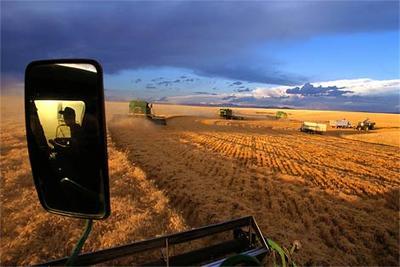
Where: Montana
When: 1997
photographer: Robb Kendrick
"A fleet of hired combines cuts 80 bushels of wheat an acre from Walter Mehmke's Montana farm. 'When I was in high school, if we cut 30 bushels an acre, that was an excellent crop,' recalled Mehmke."
—From "Special Issue: Best of America," September 2002, National Geographic magazine

Where: Puget Sound, Washington
When: 1971
Photographer: Bates Littlehales
"The splendors of the depths are known to a fortunate few, like this biologist tagging a giant Pacific octopus in Washington's Puget Sound."
—From "Special Issue: Best of America", September 2002, National Geographic magazine
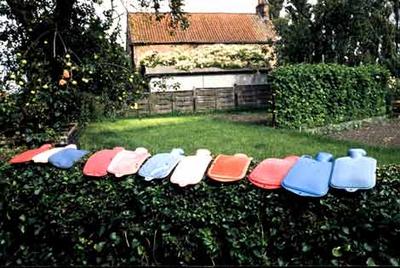
Where: United Kingdom
When: 1992
Photogragher: Sam Abell
Hot water bottles lie across a hedge. There are anywhere from a dozen to 50 or more types of hedges in Britain. Each type is as distinctive and as historic as the county in which it stands.
(Text adapted from and photograph shot on assignment for, but not published in, "Hedgerows," September 1992, National Geographic magazine)
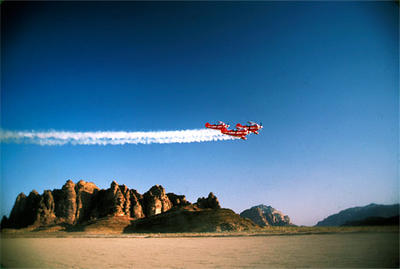
Where: Wadi Ramm, Jordan
When: 1982
Photographer: Jodi Cobb
"Acrobats of the desert skies, the Royal Jordanian Falcons trail ribbons of smoke above desolate Wadi Ramm. Sponsored by Alia, the Royal Jordanian Airline, the Falcons fly their Pitts Special biplanes to entertain small desert villages as well as air-show crowds in Europe and North America."
—From "Jordan: Kingdom in the Middle," February 1984, National Geographic magazine

Where: Assateague Island, Virginia or Maryland
When: 1975
Photographer: James L. Stanfield
Two wild ponies stand at the edge of Assateague Island National Seashore. Each year thousands of people come here to watch wild horses swim to nearby Chincoteague Island, where many of them are auctioned off. Proceeds from the auctions support the Chincoteague Volunteer Fire Company.
(Photograph shot on assignment for, but not published in, the National Geographic book The Wild Ponies of Assateague Island, 1975)
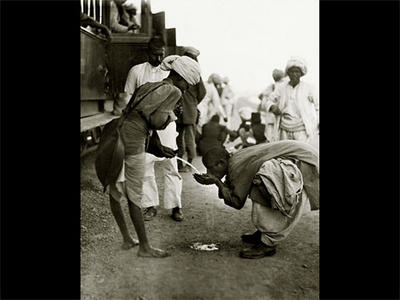
Where: India
When: Circa 1920
Photographer: Maynard Owen Williams
"The caption on the back of this picture from our archives is short and old: 'India. Watering a man without breaking caste rules.' For an Untouchable, a member of the lowest Hindu social class, the rules are many, with prohibitions on everything from physical contact with higher castes to drinking from central village wells."
—From "From the Editor," June 2003, National Geographic magazine
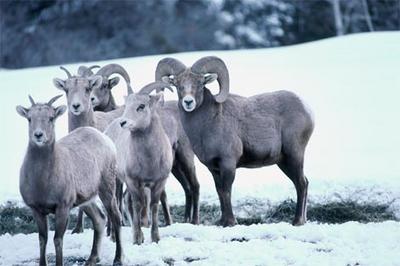
Where: Ouray, Colorado, United States
When: Unknown
Photographer: Donald J. Crump
A male American bighorn sheep allows the presence of a younger male among his herd (pictured here). Order among males is established in horn-splintering clashes, in which the frequent winner gains leadership of the herd, and pick of the breeding females.
—Text adapted from "Last Stand for the Bighorn," September 1973, National Geographic magazine

Where: Phuket, Thailand
When: 1994
Photographer: Jodi Cobb
White sand beaches, clear blue water, and ideal temperatures have made Thailand's Phuket Island a tropical paradise for visitors. Phuket is Thailand's largest island, located in the Andaman Sea, and its idyllic conditions have made tourism one of the pillars of its economy. Ten years after this photograph was taken, Phuket Island suffered severe damage from a massive tsunami triggered by an earthquake in the Indian Ocean in December 2004. Thai officials have begun a years-long program to rebuild Phuket and lure back visitors.
(Photograph shot on assignment for, but not published in, "The Many Faces of Thailand," February 1996, National Geographic magazine)

Where: Nuevo Lajitas, Chihuahua state, Mexico
When: Date Unknown
Photographer: Bruce Dale
"As other family members relax along the Rio Grande on the Mexican border, a mother dips her reluctant infant into a makeshift bathtub."
—From the National Geographic book The American Southwest: Land of Challenge and Promise, 1998

Where: Las Vegas, Nevada
When: 1996
Photographer: James A. Sugar
When gangster Benjamin "Bugsy" Siegel opened his landmark Flamingo hotel and casino in 1946 on the Las Vegas Strip, it helped usher in a seemingly endless jackpot for the city's tourism and casino trades. In 1996, the year this photo was taken, four mega-casinos made their debut on the Strip: the New York-New York, Monte Carlo, the Orleans, and the Stratosphere.
—Photograph from "Believing Las Vegas," December 1996, National Geographic magazine
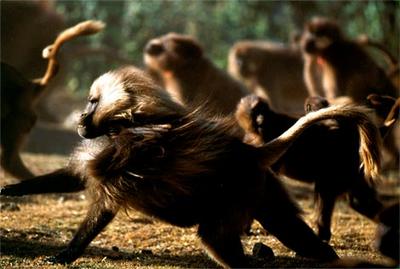
Where: Simen Mountains National Park, Ethiopia
When: 2002
Photographer: Michael K. Nichols
"Theropithecus gelada, as a gelada is properly called, is the last species in a once great dynasty of grass-grazing primates....Only in the cool heights of the mountain meadows of north-central Ethiopia did a Theropithecus-friendly habitat survive. Today between 100,000 and 200,000 geladas remain in the country."
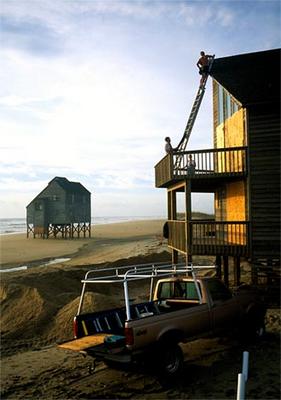
Where: Rodanthe, North Carolina
When: Date Unknown
Photographer: David Alan Harvey
Despite North Carolina's hurricane vulnerability, beachgoers are not dissuaded from living along the shore. The state has withstood many devastating hurricanes, including 1954s Hazel, which has been called the most destructive in the state's history.

Where: Ouray, Colorado
When: Date Unknown
Photographer: Donald J. Crump
Box Canyon was the site of 1800s mining claims and helped give rise to nearby Ouray, Colorado. Once a mining town, Ouray is today a resort center known as the "Switzerland of America."
Comments:
Post a Comment